Samsung Galaxy Tab 10.1 (Review)
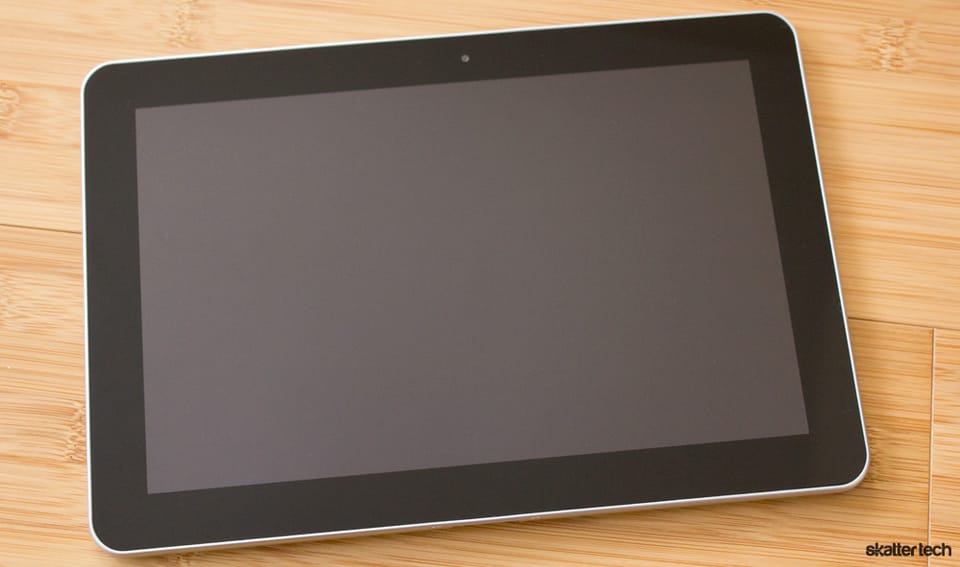
Despite an early entrance into the world of tablets with the debut of the Galaxy Tab 7 running on a smart phone operating system last year, Samsung had plans for premium Android 3.0 Honeycomb tablets in the works. The first of those announcements came at Mobile World Congress for the Galaxy Tab 10.1 earlier this year in February, but the company went back to the drawing board to create a lighter and slimmer iteration for CTIA Wireless 2011 by March to take on the newly announced Apple iPad 2. Samsung even revealed a smaller Galaxy Tab 8.9 sibling which will also hit stores sometime this summer. Although the Galaxy Tab 10.1 has an official June 6th launch date, Google gave away 5,000 limited edition WiFi-only tablets to attendees of I/O 2011.
I was fortunate enough to pick up one of these tablets while at that conference, but I should note that my review unit varies slightly from the upcoming retail version since it lacks integrated mobile broadband, does not have a custom TouchWiz interface overlay, and is missing a microSD card slot. For those not familiar, this tablet boasts dual-core processors for fast multitasking, 32 GB of internal storage, access to thousands of apps from the Android Market, HD video capture, cloud-powered music streaming, video chat, stereo speakers, and much more. A downloadable upgrade to the newer Android 3.1 operating system is also on its way.
Build Quality
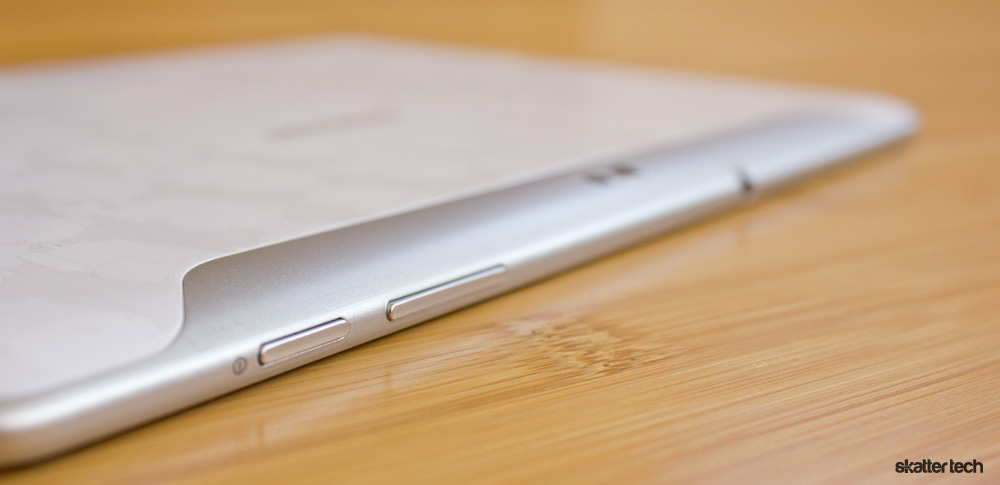
The Galaxy Tab 10.1 is just 8.6 mm thick and weighs 595 grams making it both thinner and lighter than the Apple iPad 2. For those wondering, it is not nearly as bulky as the first Android 3.0 Honeycomb tablet: the Motorola Xoom. This limited edition model features a white glossy plastic finish on the back with an Android pattern, however the retail version will have a slightly rubberized black matte coat. There is also a silver trim across the edges for additional contrast and the front face has a black border around the display creating just enough room for a good grip.
The smooth rounded edges make the Galaxy Tab 10.1 comfortable to hold and the device does not get too heavy even during extended use unlike the last generation of tablets. The three-piece design with a glass piece on the front, a robust frame around the edges, and a fixed rear plate is by no means flimsy but a uni-body build would be preferable. I hope that a future iteration will feature an industrial anodised aluminum casing for a more premium feel.
The Design
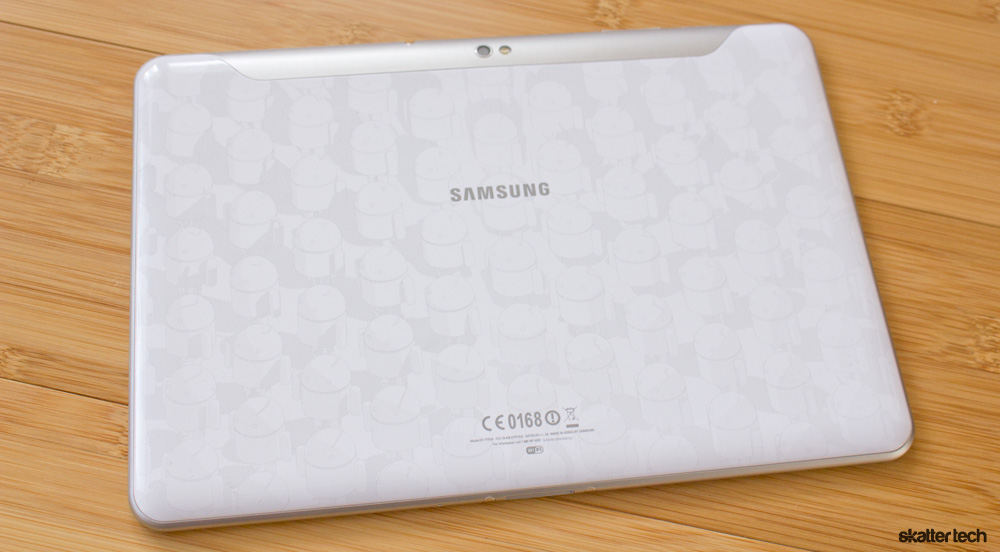
Samsung only deserves credit for design considering they have the thinnest tablet on the market. The front face is clean as possible with no buttons and the bezel surround the display is not too wide. The only noticeable mark is a spot for the 2 megapixel camera on the front for video chat. The back side features a 3 megapixel camera and an LED flash for low-light photography.
There is a 3.5 mm headphone jack centered on top and Samsung includes a pair of ear buds in the packaging. The volume rocker and a power button are also on top towards the left. I also noticed that there is a small pinhole for a microphone at the bottom while stereo speakers are on the left and right sides of the tablet. I was quite disappointed to find that Samsung chose to go with their own proprietary dock connector over a standard micro USB connector. While the included modular cable can plug into a regular USB port or into the included AC adapter, finding replacements is not as easy. Notably missing are a microSD card slot for expansion and a HDMI port for output.
Display
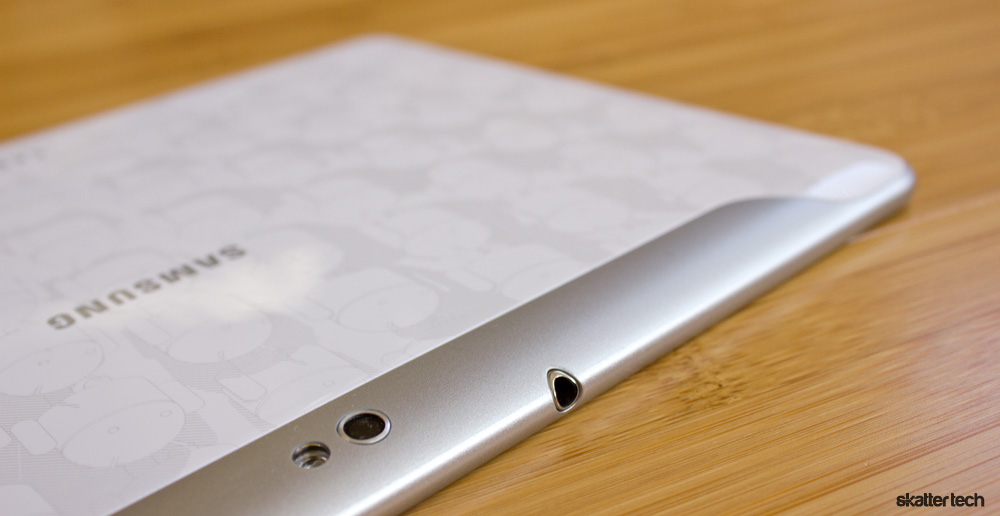
After fancying over the impressive design, I turned on the display to find myself in horror. I immediately knew I had a defective unit as soon as the boot screen loaded. There was severe black light bleeding from the edges of the screen making it look as though white jolts of light were breaking out from several sides — the bottom right corner being the worst. I asked around to find that a few others also had the same issue. Even developer forums have members complaining about this problem and we can only hope the defects are not widespread to retail models.
Setting that major concern aside, other aspects of the 1280-by-800 pixel resolution display are just fine. Despite featuring a larger 10.1 inch panel, the Galaxy Tab 10.1 still has a higher pixel density of 149 ppi compared to the 132 ppi of the iPad 2 creating a sharper image. With that being said, I should note that Apple’s IPS screens still offer better viewing angles and richer colors. Samsung’s display is not in any way problematic, but colors do look slightly faded.
Another frustration was the built-in ambient light which does not turn up the brightness enough whether in a dark room or a bright office setting. I often had to manually tweak the levels for comfortable viewing. Fortunately, other sensors such as the accelerometer work perfectly fine by rotating the display quickly when changing orientation.
Operating System
If you have used an Android smart phone, you really have not tried Android 3.0 Honeycomb yet. The new OS is heavily revamped despite the fact that it runs on similar code, supports the same set of apps, and has many familiar UI elements. Google essentially reinvented its mobile OS to take advantage of a tablet form factor with a new look, easier navigation, better multitasking, improved organization, and subtle notifications. Reading about Android 3.0 is not really as effective as seeing it in action, so I recommend watching my walk-through video above.
If my demo was not clear enough, I can definitely say that everything from the home screen interface, multi-tasking, notifications, and pre-installed apps are well polished. The refreshing out-of-the-box Tron-inspired theme tops it all off setting it apart from other tablets. Even the native tabbed browser experience is a great blend between a touch screen interface and a desktop-like browser.
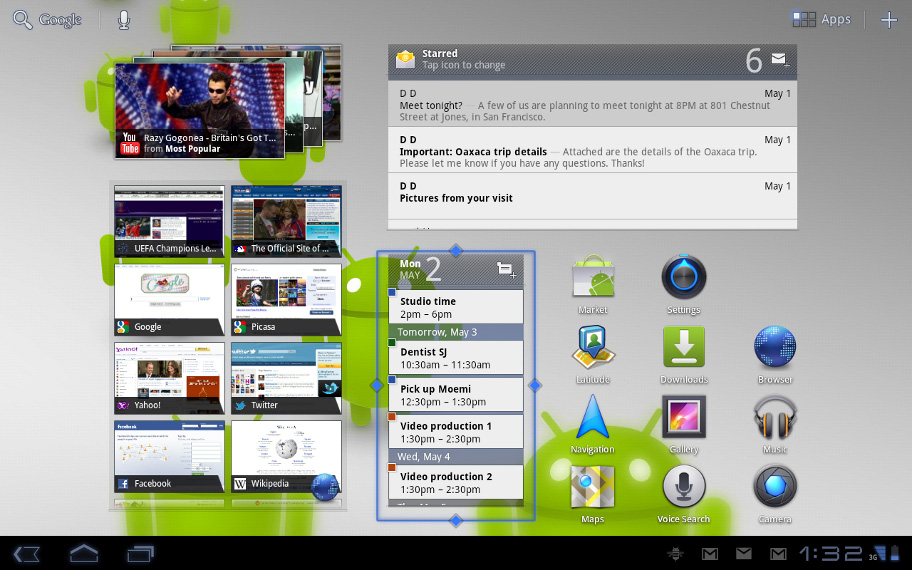
Although Google announced Android 3.1 at I/O 2011, the Galaxy Tab 10.1 still runs on Android 3.0 Honeycomb. Motorola delivered the new version to Xoom owners a few days after the conference and Samsung will apparently do the same within a few weeks. The update is merely incremental, but it will bring several improvements: support for USB accessories (e.g. mouse or keyboard), a longer list of recently used apps, resizable widgets, and Wi-Fi connectivity improvements. Other additions include polish for pre-installed core apps such as the browser, gallery, calendar, and email.
While this news sounds great, the Galaxy Tab 10.1 has a few disappointments. Unlike the unmodified version of Android Honeycomb running on the Motorola Xoom, Samsung makes several customizations of their own. This limited edition model does not even run TouchWiz yet and small quirks are already getting frustrating. For instance, this tablet ships with a custom keyboard which is bright white and breaks away from the native color scheme. It is not nearly as responsive either and I was at least glad that it is possible to switch back to the original keyboard easily.
Another issue? Samsung dumps the official camera app for their own custom interface which is rather hideous. There is a good cause for concern considering that the upcoming update will likely bring a full-blown version of TouchWiz which means more potentially unwanted changes.
The Apps
Google’s largest hurdle is now apps. Although there are over 200k in the Android Marketplace, less than 100 are tablet-optimized Honeycomb-specific apps. The situation is better than it was a few months ago when the Motorola Xoom made a debut, but not my much. With that being said, I should note that the vast majority of smart phone apps run on the Galaxy Tab 10.1 without any issues. The tablet ran just about every one of the approximately 50 apps I had on the Samsung Nexus S 4G, which runs on Android 2.3 Gingerbread, without any hiccups.
While iOS zooms into iPhone apps on the iPad, Android 3.0 handles the situation differently. Older apps scale to fill the entire screen with a fluid width versus having to run in a small centered emulator-like window. I found that most apps remained crisp and did not have to suffer from blurriness. I should note that a few Android 2.x apps were buggy and that some even failed to run on Honeycomb.
Unlike the Motorola Xoom, Samsung ships plenty of bloat-ware with the Galaxy Tab 10.1. Sadly, none of these apps are removable. Samsung bundles its own Music Hub which overlaps with the new cloud-powered Google Music streaming service. They also pre-install the Amazon Kindle app and it appears as though they even blocked Google Books from the Android Market, which runs on the Motorola Xoom perfectly. Pulse news reader and WeatherBug also come pre-loaded. There is also a Samsung App store which is oddly filled with nothing useful aside from a ton of spam.
Fortunately, the core set of pre-installed apps are a great example Android 3.0 Honeycomb’s capabilities and hopefully a sign of the things to come. Apps such as the Browser, Calendar, Gmail, Maps, Music, Talk, and YouTube are easy-to-use, fancy-looking, and powerful. Samsung even bundles a full version QuickOffice HD for document viewing and editing.
Cameras and Video Chat
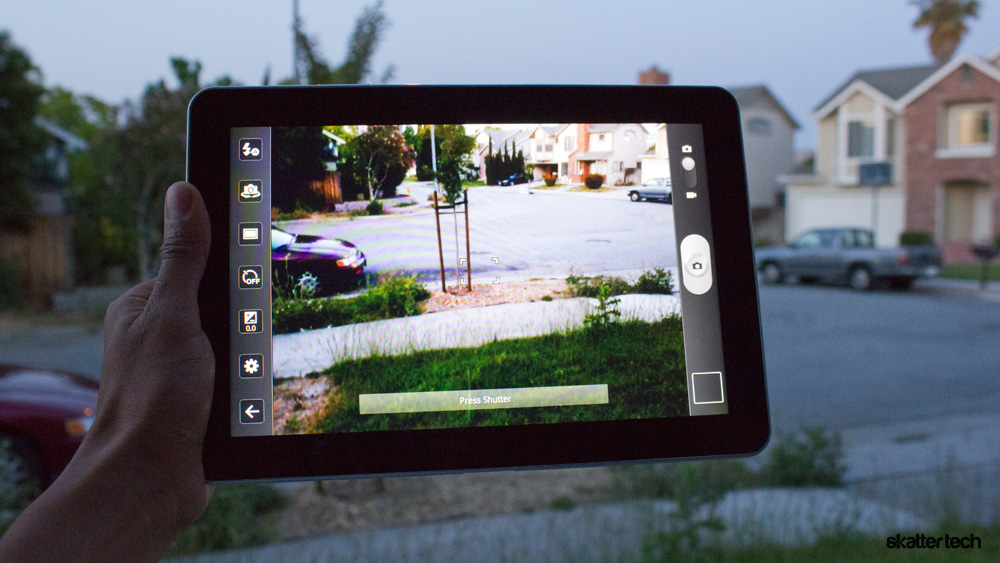
Although tablets are definitely not ideal for photography, the Galaxy Tab 10.1 packs a 3 megapixel camera on the back along with a single LED flash. Sadly, images appear too grainy even in well-lit areas. The flash helps slightly in low-light conditions, but not by much. Holding up a large tablet steadily for a photo is not too easy either. Samsung makes 720p video capture possible, but there is not much to tout. While the inclusion of the feature is definitely welcome, a better camera such as the 5 megapixel sensors on the BlackBerry PlayBook is preferable.
Fortunately, the 2 megapixel front-facing camera adds a lot more value. It works perfectly with Google Talk out of the box for video calls. Quality was actually quite impressive. I had no issues calling others using a Chromebook, a Nexus S 4G, or a Windows laptop. The app even makes it possible to continue a voice-only conversation while multitasking which is a neat touch.
The Google Talk app also provides image stabilization for steady video streams. Music playback automatically fades away to a pause when you answer and incoming call. Notifications are also non-intrusive to your workflow. Third-party apps such as Tango make it possible to enjoy video calls with iPad and iPhone owners, but I still hope to see Skype make its way to Android tablets soon.
Battery Life
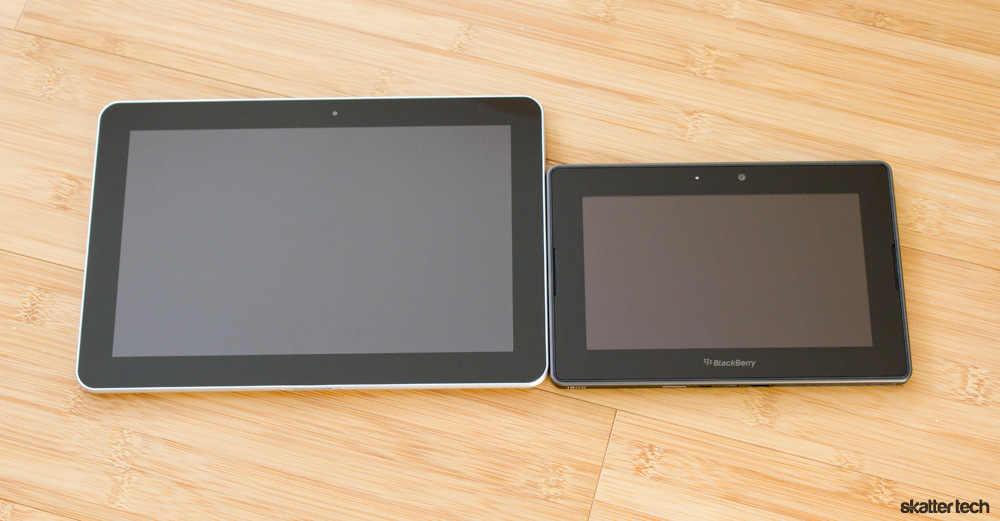
With a whopping 7,000 mAh battery inside, the Galaxy Tab 10.1 can keep going for at least a full week with moderate daily use. For those wondering, my general routine involves browsing the web, possibly playing a short Flash video, checking emails, glancing at my calendar, enjoying some music, placing a video call, and even looking up directions.
I would have to say the Apple iPad 2 still might have slight edge over this tablet when it comes to lasting on a single charge, but not by much. This tablet can definitely last through a full day of rigorous use and likely through an entire work week for most. Being a WiFi-only tablet also helps compared to those with 3G or 4G modules eating away battery inside.
The Bottom Line
If you are in the market for a new tablet, the Samsung Galaxy Tab 10.1 is a great choice. In fact, it is likely the best Android tablet on the market. The hardware makes no compromises with a dual-core processor, plenty of storage, a large 10.1 inch screen, and plenty of battery life not to mention being the lightest and thinnest tablet on the market as well. The largest concern is the relatively young Android Market for tablets which is still maturing. Customizations to the native operating system with TouchWiz is also a potential problem. Assuming that Samsung delivers on timely updates and developers begin pumping up tablet-optimized apps, this tablet will have a bright future.
For those wondering, the most comparable retail model to the 32 GB version featured in this review will probably sell for $599 while a more affordable 16 GB option will sell for just $499. Samsung is also working with major cellular carriers for 3G/4G mobile broadband enabled iterations which should make their wait to store shelves in just a few weeks.
Links: Samsung Galaxy Tab 10.1